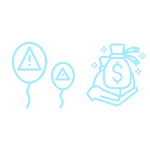Trading in the Forex market sometimes requires taking risks in order to gain a substantial profit. The Forex risk reward ratio is the amount of money someone is risking to generate a high number of payouts. A lot of beginner traders don’t know why is it so important to calculate the risk in Forex. Risk management is a very key factor in the market, so it is very essential to analyze fully the concept of risk/reward ratio and find out everything about it in order to trade successfully and to achieve the best.
The risk-reward ratio is used by the investors to control their capital and risk of downsides and losses. There is a balance between how much one risks in order to earn a high amount of profit. This balance needs to be highly assessed and managed to avoid bad circumstances. The risk-reward ratio is created precisely for this reason as it helps investors to evaluate the expected income and risk of the trade.
The perfect risk/ reward ratio is considered to be about 1:3 which means that every unit of risk is three units of expected profit. However, there is no such thing as the most optimal ratio because it is different according to the various trade strategies. This ratio is the perfect way to manage risks while trading in Forex. Traders ofter use stop losses, this is the amount of the risk you make to reach the hopeful return. The main idea behind this tool is to find all the opportunities that will help people generate substantial wealth.
In this guide, we will further discuss every detail related to the risk/ reward ratio, analyze all the key factors and main characteristics. Besides, we will find out how this ratio is calculated by the Forex risk reward calculator and why is it so important for the traders’ future success in the Forex market.
How to Calculate Risk and Reward Ratio?
 Investing money in the Forex market is related to the specific amount of risk. This is an irreplaceable part of trading and the key factor for gaining essential profits. So if one is taking some risk, he should also be ready to pay for it. This is how the market works.
Investing money in the Forex market is related to the specific amount of risk. This is an irreplaceable part of trading and the key factor for gaining essential profits. So if one is taking some risk, he should also be ready to pay for it. This is how the market works.
The formula for calculating the risk vs reward ratio is very easy. You should just divide the net profit (the reward) by the price of the maximum risk. If one risks 40 pips on the trade and they set a profit target of 80 pips, then their risk and reward ratio would be 1:2. This means that they risk 40 pips in order to get a reward of 80 pips. This is a ratio that many professional investors are interested in as it gives investors an opportunity to double the capital. However, while computing the risk and reward ratio, it is also very important to consider the spreads which is charged by the broker.
Every person has their own tolerance towards the risk levels. This means that the Forex risk reward ratio changes in each case. Let’s discuss the calculation process in a detailed way. As we have already said, calculating the risk/reward ratio includes dividing the net profit (the reward) by the price of the maximum risk. There are several steps that investors should follow while calculating the ratio. First of all, you should make very detailed research and only pick the stock after that. Then you should set the upside and downside targets according to the price at the given moment. After that, compute the risk/reward ratio. Then the trader is recommended to assess the situation. For instance, if it is below the limit level, increase the downside target to reach a sustainable ratio. If this level can’t be achieved, one needs to try again with a different investment.
Calculating the risk-reward ratio with the payout rate is also a very important thing. This helps traders to find out whether their trading strategy is going to be successful or not. The formula is the following: P = (1+(X/Y)) x Z – 1. Let’s discuss what each of these symbols represents. P is the success rate, X is the amount of the average payout, Y is the amount of the average loss and Z is the rate of the payout. This information gives us the opportunity to assess the future success rate of the trading. Let’s talk about the examples to better understand the main concept behind the Forex risk reward ratio formula.
Let’s consider that we made 10 trades out of which 3 weren’t successful and 7 gained us some profit. This means a payout rate of 7/10 that is 70%, the same as 0.7. Suppose that the total income was 5000 USD. 5000/7 equals about 715$ which is the average payout. Considering unsuccessful trades, let’s suppose that the net loss was 3000 USD. This means that the average loss would be 1000$. Applying these information to the formula P = (1 + 715/1000) x 0.7 – 1. After calculating this number, we will find out the exact success rate that will show us whether the trading strategy would work or not.
Recommendations About Risk-reward Ratio
 As we have already mentioned above, some market experts say that the ideal risk and reward ratio is 1:3. Sometimes this number goes up to 1:5. We can see some similarities with leverage. However, some considerations should be considered carefully. For example, it’s important to mention that sometimes investors miss the chance to enter a beneficial trade. In many cases, this happens when traders aren’t sure about themselves, so they want to evaluate the risks before they enter the market. So this might sometimes lead to the missed opportunities.
As we have already mentioned above, some market experts say that the ideal risk and reward ratio is 1:3. Sometimes this number goes up to 1:5. We can see some similarities with leverage. However, some considerations should be considered carefully. For example, it’s important to mention that sometimes investors miss the chance to enter a beneficial trade. In many cases, this happens when traders aren’t sure about themselves, so they want to evaluate the risks before they enter the market. So this might sometimes lead to the missed opportunities.
Some experienced investors say that the most recommended risk and reward ratio is 1:2. This is because they believe that it can maximize the payout and limit the losses. However, there is no perfect number ratio that is appropriate for every kind of trading. We have already discussed that the Forex risk reward ratio strategy is dependent on the investor’s trading goals as well as the Forex market situations. It is always a key factor to remember that the Forex market is changing uninterruptedly. It is up to each trader to decide what ratio would be beneficial for them and which one suits their needs. It is highly recommended by the professionals that beginner traders should avoid trading with high risks and low rewards because it requires a lot of market skills and experience. Otherwise, they might end up losing a big amount of money and also opportunities for great success.
The main idea behind all these is that there is no perfect risk and reward ratio that might work for every trader. You should just pick the one according to your needs and main trading goals.
The Bottom Line
Risk management is a very essential concept in the Forex trading market. Assessing the risks might help a lot of investors generate a good amount of profit and gain a good trading experience as well. We have already mentioned that The Forex risk reward ratio is the money an investor is risking in order to gain a high number of returns. A lot of newcomer doesn’t know how the latter works, however, it is a very important concept and one needs to get familiar with it before he starts trading because in many cases, this is a very big help for investors to maximize their potential profits.
The most optimal level of risk and reward ratio is considered to be 1:3. However, this doesn’t mean that this is the only option for every investor as it depends on their trading goals and market performance at the given time.
We have already analyzed how to calculate the ratio. For some people, it may seem a little puzzling, however, while getting the main idea behind it, the computing process will become a lot easier and less boring. Overall, an investor should assess the market situation very attentively and then pick the right risk and reward ratio that will be the most appropriate for them at the given time.

